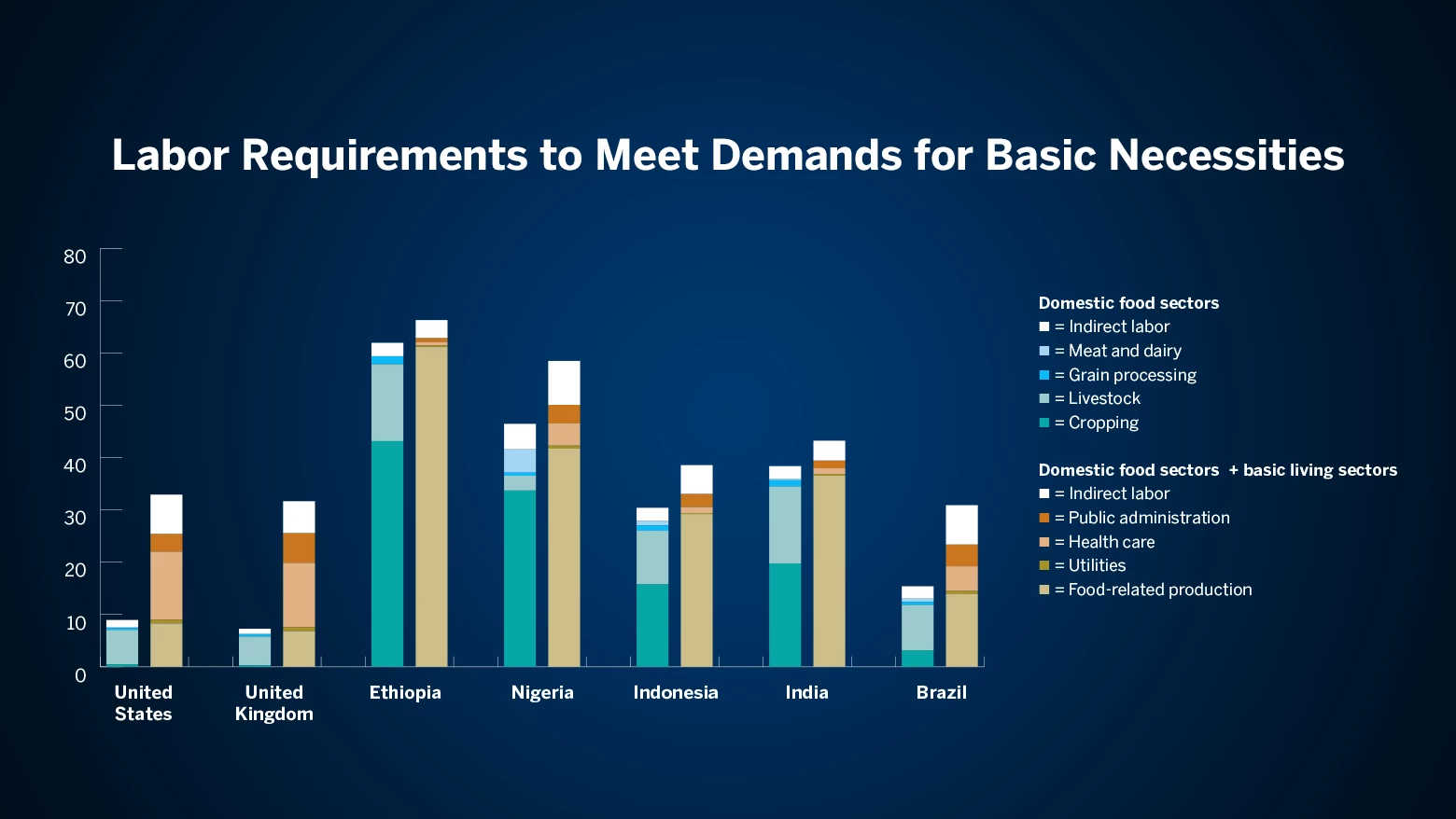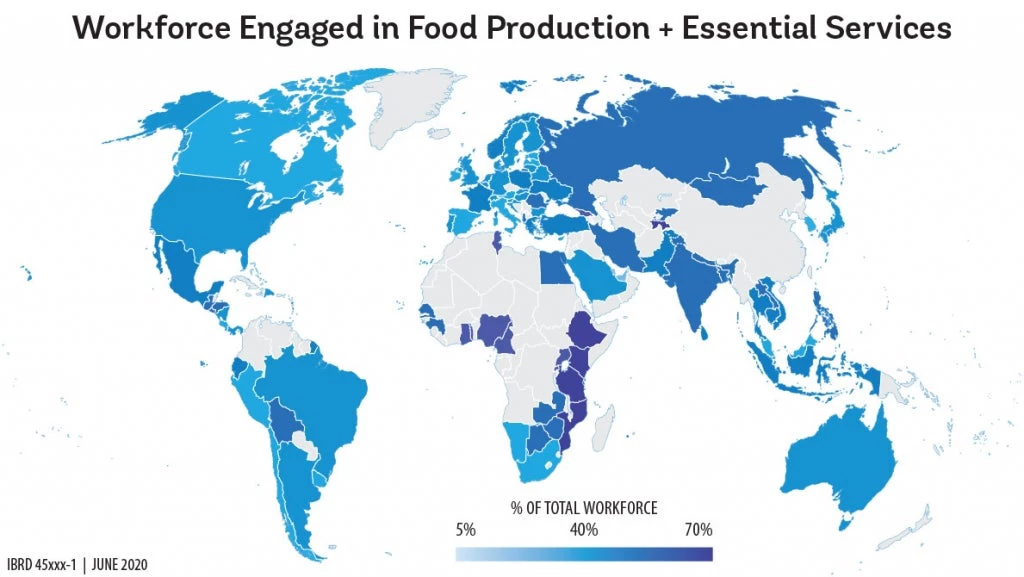 Un mercado en Kenia en abril de 2020. Fotografía: © Sambrian Mbaabu/Banco Mundial
Un mercado en Kenia en abril de 2020. Fotografía: © Sambrian Mbaabu/Banco Mundial
Countries around the world have been hit hard by the coronavirus (COVID-19) and the containment measures it has necessitated. The crisis has stalled economic activity, with only essential activities and remote work allowed to continue. Over and above the lives lost directly to the virus, millions have lost their jobs and incomes due to containment measures. All affected governments have introduced emergency measures to help families and firms smooth the economic impact.
In high-income countries, the main concern has been to maintain households’ purchasing power, in particular through cash transfers and expansions to unemployment insurance, and to protect firms from bankruptcy. With few exceptions – for instance, disruptions to the meat industry – there have been few issues with maintaining the production of essential goods and services, such as food, water, and power.
Low- and middle-income countries have largely followed the same approach as wealthier ones, combining containment measures with a massive boost in social protection spending. In this post, we investigate how developing countries differ in their ability to maintain such containment policies. We argue that these countries face a much more difficult situation than their high-income counterparts because, even assuming that social protection systems could fully replace lost income and protect firms from bankruptcy, maintaining access to essential goods and services is impossible if these can’t be produced in the first place.
What is the “containment divide”?
To compare the situation in developed and developing countries, we quantified the share of the labor force needed to produce essential goods and services, such as in food, health care, power and water utilities, taking into account sectoral and international inter-dependency. The analysis relies on the GTAP input-output table (ver. 10), which describes how much each sector buys and sells with other sectors, domestically and internationally. We also compiled comprehensive labor data from the International Labour Organization from 21 sectors across 210 countries and mapped it into the GTAP 65 sectors and 140 countries. This rapid analysis does not cover all countries and does not include informal workers, so the results can be considered as conservative estimates.
As shown in Figure 1, less than 10% of the workforce in the United States or the United Kingdom is sufficient to satisfy domestic food demand and ensure food security, even taking into account indirect needs in non-food sectors (such as the availability of fuels for tractors and delivery trucks) and downstream activities (such as logistics and retail sales). If we add in other basic goods and services – here including health care, energy and water utilities, and public administration – the share increases to around 30% of the workforce.

In lower-income countries, however, the situation is vastly different. The poorer the country is, the higher the proportion of its employment in food-related sectors: we find that food production employs up to five times more workers in low-income countries than in high-income ones. For example, Ethiopia and Nigeria have 60% and 42% of their workforce engaged in food production, respectively. The two countries also have another 3-5% of their workforce producing the services needed for food production. Other essential goods and services represents a further 4-12% of the workforce, bringing the total to around 66% for Ethiopia and 58% for Nigeria.
"The poorer the country is, the higher the proportion of its employment in food-related sectors: we find that food production employs up to five times more workers in low-income countries than in high-income ones."
The maps below illustrate the share of the work force who are engaged in food production only (top panel) and in food production along with other essential activities (bottom panel). Our analysis finds that low-income countries need around 60% of their workforce to stay active, mostly in agriculture. Even if efficiency gains may be able to decrease this share, they cannot keep much more than 40% of their workforce in containment without threatening their ability to satisfy the basic needs and food security of their population. For high-income countries, in comparison, producing essential goods and services requires less than 35% of the workforce, and mostly in non-food sectors, in which remote work is easier: so it’s feasible that over 60% of their workers can stay home.


Implications for decision makers
Most of the essential workers in low- or middle-income countries are engaged in agricultural activities in rural areas, where containment is easier than in downstream activities like logistics and retail sales of food in cities. For instance, governments can facilitate the production of essential goods and services by targeting containment to urban areas and ensuring protective equipment is available for all exposed essential workers. Although this will also be no mean feat: protecting these workers – 800 million people in the countries included in this analysis, not including informal labor – will be a significant challenge.
Assuming that health workers need high-quality N95/N99 masks at $5/unit, while other workers need common blue masks at a cost ranging between $0.5-$2, providing one mask per day to all workers in essential activities for three months would cost $102-277 billion. This cost can be challenging for low- and middle-income countries. For instance, it could cost Ethiopia about 10% of its GDP within three months, not including other hygiene-related costs such as appropriate clothing, easy access to improved water and soap for handwashing, and so on. In addition to the financial cost of protection equipment, poor countries will face many challenges to access markets in the current context of global scarcity and competition among buyers. In spite of recent efforts to ramp up capacity and a shift toward home-made cloth masks, daily production of protection equipment is still well below the estimated 800 million masks required globally each day.
These figures highlight the challenges of containment in developing countries, where replacing lost income through social protection may not be enough to stem the immediate impacts on basic consumption, and even survival. The implications of this “containment divide” offers some clear lessons for policy makers:
- Tailored solutions are key: adopting an approach that works for developed economies may not be appropriate for developing ones. Hence recognizing the divide and adapting to it is essential.
- As countries start to plan the reopening of critical sectors, planning should already be underway to ensure that all essential workers in all countries can access vital equipment. This will require coordination between countries as well as global support from the international community.



Join the Conversation